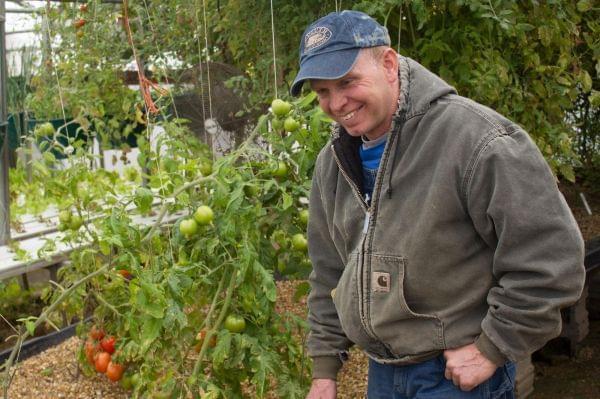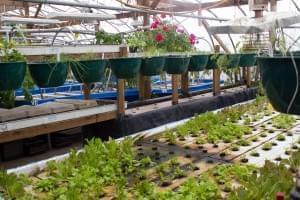Nature Vs. Nurture: Hard To Measure Farmers’ Impact On Nutritional Values

In his aquaponics greenhouse, Iowa farmer Jeff Hafner grows tomatoes, lettuce and other produce year-round, though he has to adjust the varieties as the indoor temperature and humidity change. Amy Mayer/Harvest Public Media
No matter how far fruits or vegetables travel, whether they’re grown organically or conventionally, they’re packed with vitamins, minerals and other necessary nutrients. The men and women in the fields try to grow foods with an eye to boosting the health factor, but researchers say it’s hard to measure the precise impact.
Consider the orange, a fruit high in vitamin C, which boosts the body’s immune system. One from a tree in Florida and another of the same variety grown in California won’t have identical values of the scurvy-fighting vitamin.
“There's going to be slight differences in the amount of vitamin C by the cultivar, the type of fruit that it is, where it's grown, how long it's been on the store shelves,” Iowa State University food science and human nutrition professor Ruth MacDonald says.

Iowa State food science and human nutrition professor Ruth MacDonald says looking at people's weekly diets, not the nutritional content of one particular food, is how a nutritionist evaluates whether people are getting what they need.
The differences might even be significant, but she says, “it's really what you eat on a weekly basis that really makes the most impact.” MacDonald, who’s also an interim senior associate dean, adds it’s “not one single nutrient in one piece of fruit at a time.”
It’s also really hard to make comparisons because there are so many variables on a farm and not a lot of public or private research money available to study nutritional variation among varieties.
Breeders’ choice
Plant breeders and farmers tend to look at growing foods with specific qualities in mind.
“They usually check for acidity, sugar content, soluble solids, lycopene,” North Carolina State University extension horticulture specialist Chris Gunter says.
But neither farmers nor consumers will pick something like a tomato for its lycopene — an antioxidant that gives tomatoes their red color, and is thought to have health benefits — alone.
Farmers will pick varieties they expect will grow well in their soil, with their climate conditions and their preferred fertilizers or pesticides.
But there’s the customer to keep in mind, too, who might want a soft or bright red or juicy tomato or one with lower acidity.
“People are very interested in, does the whole fruit, consumption of this fruit, impact my health as a consumer?” Gunter says.
From the farm

Iowa farmer Jeff Hafner says February is a particularly warm and humid time in the greenhouse, so he selects lettuces that can withstand the conditions.
It’s a balance Jeff Hafner strives to achieve. He and his family run Early Morning Harvest, a diverse farm in Panora, Iowa.
With produce, he adheres to one guiding principle: “If you don't think it looks right, throw it out. Chickens will eat it.”
Those vegetables will contribute nutrients to the eggs they lay; Hafner says every aspect of the farm nurtures another.
“The more nutrients in the system, the healthier the system's going to be,” says Hafner, “the healthier the products are going to be, the more nutrient dense the products are going to be.”
The chickens’ eggs, for example, tend to have dark yolks, which he says reflects the hens’ varied and nutrient-rich diet. He doesn’t know whether that makes the eggs healthier for people, but it’s one of the reasons customers come back, along with the cache of a “farm-fresh egg” and, Hafner adds, “usually the taste, also.”

Water from tilapia tanks circulates in the greenhouse at Jeff Hafner's farm, bringing beneficial bacteria to the crops growing without soil. The fish are also marketed, though he says they aren't a focus of the operation.
His produce grows in an aquaponics greenhouse, where tanks of tilapia create water that’s rich with beneficial bacteria. He uses the water for his kale, lettuce, tomatoes and cucumbers in a process he’s had to figure out over time.
“My first crop of lettuce in aquaponics was white,” Hafner says, “because it was built around nitrogen. As the system matured, the crops were healthier.”
In general, he tries to be transparent about how he grows the food and lets consumers decide whether it meets their needs.
Adding nutrients
As important as farming practices can be, MacDonald says they’re not the most efficient way to increase a food’s healthfulness. That is best done in a lab or at a processing center, where iron is added back into flour and milk is fortified with vitamin D.
“It's easier to add the nutrients to the food after the fact,” she says, “and it's more consistent and it's more bioavailable.”
The USDA keeps two databases to help people understand where the nutrients are in their food: The National Nutrient Database lists the nutritional traits of a wide variety of foods, including fresh vegetables and specific brands of packaged foods. A separate database, the Nutrient Content of the U.S. Food Supply, compares which foods have provided Americans with which nutrients historically (spoiler alert: we’re eating more fat and protein).
The takeaway? Don’t skip the fruits and veggies, just eat a variety to get the best possible array of their benefits.
Follow Amy on Twitter: @AgAmyInAmes
Links
- Soaring Popularity Of Grass-Fed Beef May Run Into Roadblock: Less Nutritious Grass
- Are Organic Vegetables More Nutritious After All?
- Why Lots Of Grass-Fed Beef Sold In U.S. Comes From Down Under
- Grant Dollars For C-U Promote Healthy Living
- ‘Healthy Eating’ Facts And Fictions; Rural Homelessness; Women In Comedy Weigh In On Louis C.K.

